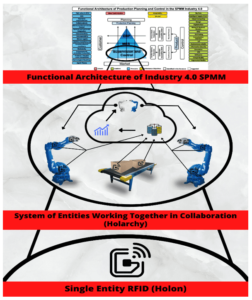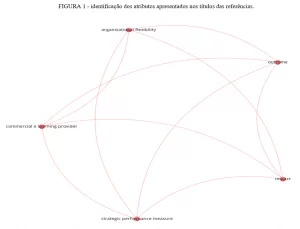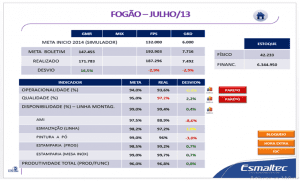GIRO, Leandro Henrique Vitorino [1], BRAGA, Francisco Andrea Simões [2], PIAGGE, Ricardo Magnani Delle [3]
GIRO, Leandro Henrique Vitorino; et.al. Application of a Project Management Model in an Enterprise of the Large-Scale Food Sector. Multidisciplinary Scientific Journal. Edition 8. Year 02, Vol. 05. pp. 23-38, November 2017. ISSN:2448-0959
ABSTRACT
The competitiveness of the food sector is constantly growing and the consumer is becoming more demanding. To meet this demand, it is indispensable that the company has products with more affordable prices, greater diversity of choice and with a high level of quality. One way to manage improvement projects in a company is by applying a Project Management (GP) model. The objective of this article is to identify the barriers to the application of a project management model in a large food company. In order to achieve this objective, a bibliographic review will be carried out on the concepts of some existing project management methods. The purpose of the review is to construct a theoretical framework that precedes the application of an action research in a large company in the food sector.
Keywords: Project Management, Improvement, Barriers, GP Methods.
1. INTRODUCTION
We can say that the history of food industrialization in Brazil occurred after the industrial revolutions and the first manufacturing activities developed in Brazil settled in a scattered way, still in the colonial period. With the help of foreign capital, in 1920 the food industry accounted for 40.2% of the total production of all industries in the country (COSTA JUNIOR, 2009). In the twentieth century, the strength of foreign capital was increased, where it was the leader of the food sector, with a participation of about 14% of the total, surpassing even the oil industry (BIRCHAL, 2004).
Even with the milestones in the internal market stabilization plans (Collor Plan in March 1990 and Plano Real in June 1994), the food industry remained stable. In 1991, with the Collor II Plan and the return of high levels of inflation, there was a need to edit the Real Plan, with this, the food industry was very privileged by the real increase of income in the period (SATO, 1997).
With every passing year the food market has grown rapidly. According to ABIA (Brazilian Association of Food Industries), in 2016, the industries of the (Food + Beverage) sector closed the year with revenues of 614.4 billion Reais, about 9.3% growth in relation to last year.
Given the growth of the food industry in the national and international scenario, coupled with the level of demand of the consumer that has been growing year by year, always seeking greater variety, speed and flexibility of the companies, without leaving aside the cost of the product. Companies in turn have been investing in the development of new products, new services and new business models so that they can keep up with this growth, ensuring the satisfaction of their consumers. These investments generate the need for increasingly flexible and robust industrial processes.
To gain competitiveness, effective methods are needed to manage improvements, as well as a work model that best manages organizational projects.
According to Patah and Carvalho (2009), project management standards are widely used to align business strategies and unfold them across all areas of the organization, measuring job performance and generating information for key stakeholders.
However, to continue improving the industrial processes, it is necessary to have a project manager. It will focus on improvement processes while the functional manager gets the focus on the routine.
The operations managers were no longer efficient in dealing with the projects, which required another organizational structure, which is the matrix structure. This new structure may be weak matrix, balanced matrix or strong matrix. The greater the power of the project manager, the stronger the classification of the structure (PATAH AND CARVALHO, 2002).
In a functional framework or weak matrix structure, the primary power is the functional manager and when a prioritization is required, between design and routine, it is always the winning routine. An empirical study carried out with a sample of 546 development projects showed that the chances of projects succeeding in a balanced or strong matrix structure is greater than in a weak or functional matrix, since there is a significant difference in the delivery of deadlines and in the control of costs (Larsson and Gobel, 1999).
Five decades ago, working on improvement projects was simpler because, at that time, companies could survive on a few product lines. Operations managers also worked on improvement projects, were part of a functional structure, where the project manager was also the manager of the technical department (PATAH, CARVALHO, 2002).
With the business environment increasingly competitive, companies need to expand their product types to survive in the market, ie to increase their product lines, as well as to improve their technologies. In industries where the production system is continuous, in Mass or Lots, the focus is production. There is a great difficulty for functional managers in dealing with the day-to-day routine and also with improvement projects.
Given the context, the environment, plus Patah and Carvalho who talk about the importance of using GP to manage the critical aspects of the business, this work aims to raise the challenges of implementing a project management model, through a research in a large food company.
In order to reach this objective, the work was structured in five sections, being: Introduction (section 1); a bibliographic review on some methods of Project Management (section 2); then the applied research methodology and the description of the data collection tools used (section 3); following are the results found in the action research (section 4). Finally, an analysis of the results of the research and the study of possibilities for future studies, as well as the contribution of this present work to academics and practitioners (section 5).
2. METHODS OF PROJECT MANAGEMENT (GP)
In this section, which has as its central theme Project Management (GP), a review will be carried out on what is project and what is project management and then a quick analysis on some of the lines of thought in GP, of each.
Project is the effort to elaborate a product, service or result, whose completion is certain, once the planned objective is reached, when there is evidence that the objective will not be reached, or when the need for the project to cease to exist , for example if the client wants the project to end (OGC, 2009).
Working with projects is living in an environment of uncertainties due to the differences from one project to another. The planning must be with constant effort, since often the project tasks are new and may depend on several levels of the organization, with a responsible or composed of a team with several members, one company or several organizations (AMARAL et al, 2011).
Project management is the job of the professional who has the necessary competence to apply the best practices and tools to manage projects so that strategic objectives and business are achieved (AMARAL et al, 2011). By managing the projects well, the organization will surely succeed in reaching its objectives (KERZNER, 2006).
There are several standards or guides to good practice that help drive the projects. Each model has its line of thought and focus, which are considered pillars in support of its working characteristics. The following will briefly review the perspectives of some models such as PMBOK, SCRUM, PRINCE2 to APM.
The focus of the PMBOK (Project Management Body of Knowledge) methodology is in the processes, as support to reach the defined scope. The techniques are scattered in five process groups, which are Initiation, Planning, Execution, Monitoring and Closing (PMI, 2013).
The GP knowledge is divided into ten areas: integration, scope, time, costs, quality, human resources, communications, risks, acquisitions and stakeholders. These areas are related through the various inputs and outputs, throughout the development of the work, through processes and subprocesses with the aid of techniques and tools. With regard to how to document and control the activities of a project, the documentation is detailed, since the methodology itself proposes to propose guidelines for the execution of each of the project management activities (PMI, 2013).
When we analyze PRINCE2 (PRojects IN Controlled Environments) methodology, the focus must be the final product, one of the principles of the methodology is that all projects must have a defined organizational structure, joining multiple areas within the company dedicated to the project, management and the decision-making process (OGC, 2009).
PRINCE is a generic method, it can be applied in various types of organizations, regardless of the type of culture or size. Because it is generic, it is highly comprehensive in its application, it can be integrated with various specialized aspects such as engineering models, organizational change management, or purchasing (OGC, 2009).
SCRUM is an agile methodology that brings transparency and speed to the project. This type of method can be a great choice in complex and unpredictable projects, where it is not possible to predict everything that will happen, it provides a group of practices that brings visibility to those involved. A good implementation of SCRUM will create a culture for the project team focused on performance, thus creating value to the organization, stable communication between all levels and consequently quality (SCHWABER, 2004).
The APM according to Brandão (2010), is a model that is used in unstable and challenging environments, as it assists the project team in understanding the problems. Its basis is to build products in an agile and adaptable way as well as train teams to have these characteristics. The same author highlights the principles of the APM that is based on four main values, being:
- the reaction to change is the prioress of a definite plan;
- the delivery of products is more important than the delivery of documentation;
- the focus is on collaborating with the customer rather than contract negotiations;
- the interactions of individuals are more important than processes and tools.
To close the literature review, Table 1 shows in a simplified way, the focus of the four mentioned methods and also, their potential contribution to research of this work.
Table 1: Synthesis of GP methods and their bases of performance
| Method | Focus | Can Contribute to Research |
| PMBOK | Processes | Standardization, detailed documentation, history for future projects. |
| PRINCE2 | Integration of areas | Union between areas, ease with management and with decision making process. |
| SCRUM | Performance | Speed in application, transparency and visibility to those involved. |
| APM | Quick product delivery | Low bureaucracy, client approach, interaction with areas, rapid response to change. |
Source: The authors themselves
3. RESEARCH METHODOLOGY
In order to reach the objective of this work, the research method used was descriptive with a qualitative approach, in order to identify important facts for the implementation of a project management model, with registration and analyzes of unstructured interviews with employees of the area directly affected by the project. model.
3.1 Methodological characteristics
It is important to highlight and differentiate the research approaches, being: quantitative, qualitative and combined.
The quantitative approach uses the theory or concepts as the north, seeking to prove the results through mathematical models. Its focus is on measurability, causality, generalization and replication. The measurement of research variables is the most important feature of the quantitative approach, which allows data to be provided for hypothesis testing (MARTINS, 2012).
Causality seeks to prove the relationship between dependent and independent variables. The generalization studies the probability of extending the obtained results to other cases, outside the limits of the realized research. Replication deals with the possibility of replicating the research of another author, seeking to discover the validity of the concept, with another population, locality, etc. (Martins, 2012).
In the qualitative approach, the subjective reality of the individuals involved in the research is considered relevant and contributes to the development of the research. It tends to be less structured to capture the perspectives and interpretations of the people surveyed, which does not mean to be less rigorous, but it makes the control of research more critical. The concern is to obtain information about the perspective of individuals, as well as interpret the environment in which the problem occurs, this means that the natural environment of individuals is the research environment (MARTINS, 2012).
The combined approach, as the name implies, combines the qualitative approach with the quantitative one, in order to create a complete method, improving the individual weaknesses of each and joining together the best of the two. With this, one can use all the available means of research, rather than being stuck in a single approach, therefore the evidence will be more comprehensive than would be available from the single approaches. However, the combined approach is appropriate for answering research questions of any class (MARTINS, 2012).
Among the research methods that are best suited to conducting qualitative research in the field of production engineering are case study and action research. What differentiates the two methods is how much the researcher is involved with the individuals and with the organization, whether the researcher participates or not of action, in the context of the research. (Martins, 2012).
In the case study, the interaction with individuals and with the organization is minimal. Action research focuses on research in action and works through cyclical steps composed of planning, action, action assessment and generation of additional planning, so on. It is participatory, that is, the individuals in the study system have great involvement (MARTINS, 2012).
The research itself is an opponent of action, because at the same time that a concept is idealized, action must also be effective. In order to understand the theory in a practical environment, action research involves the researcher in the organizational environment, bringing results with learning and contribution to the theory (COUGHLAN; COGHLAN, 2002).
According to Coughlan and Coghlan (2002), for implementation of the action research it is necessary to follow three steps, being: Context and Purpose, Action-Cycle of Action and finally Monitoring. Figure 1 represents the implementation of action research:
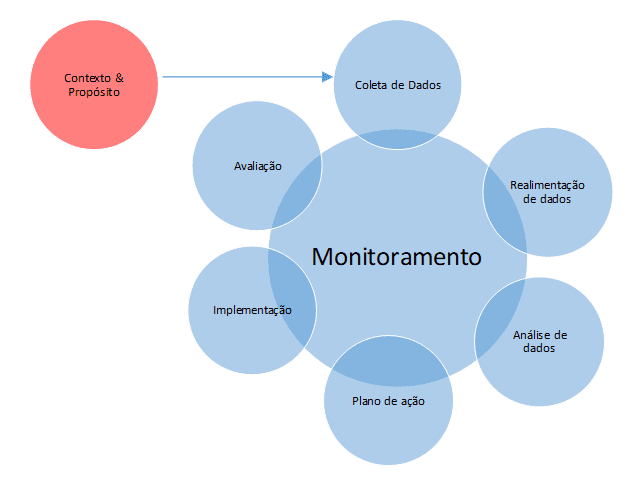
Data collection for the action researcher is through involvement in organizational processes, through observation, interviews and discussions, and may have a formal or informal configuration. We highlight a data source of great importance when we have behaviors that are directly observable, such as group dynamics, use of power, problem solving, decision making, leadership behavior, complaints, that is, a situation that can be drawn (COUGHLAN and COGHLAN, 2002).
3.2 Operational procedures
The application of action research in the company studied is not focused on the GP model, but rather on the difficulties and barriers that may interfere with the progress of the implementation. Data collection and analysis were performed in three stages, each with specific tools, as observed in figure 2.
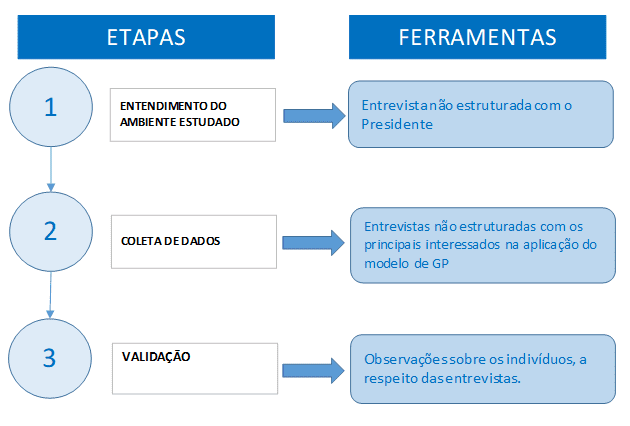
The first step allowed the authors a general understanding of the organizational structure of the company, which facilitated the selection of the means for data collection, besides allowing the identification of the interested parties in the application of the GP model.
Data collection was done through unstructured and informal interviews. We sought to understand the perspective of the main stakeholders involved in the implementation of the GP model in order to identify possible obstacles that could hinder the implementation of the GP model.
The validation was conducted through the direct observations made by the researchers based on the interviewees' reports in order to check the affirmations and highlight the main barriers encountered for the implementation of the GP model in the company under study.
3.3 Implementation of the GP model
The implementation of the model to manage the projects was divided into five phases. Figure 3 shows diagrammatically how the divisions of these phases were performed.

The initiation phase seeks to understand the first information that must be known, such as important data and scope constraints. The concern should be directed at the macro understanding of the implementation, that is, in knowing which influences that interfere in its success, such as risks and initial requirements.
Already in the planning phase, the information requires a greater level of detail. It is necessary to predict the measurement of the objectives, from monetary values to the amount of labor force involved.
During the execution phase, the focus is the exercise of what was planned. Record the progress and document the partial conclusions of the scope, having proof of the acceptance of each of them. While implantation is taking place, intervention should be done if necessary, based on the contrast between plan and achievement.
Monitoring takes place in parallel with execution, as this is the way to ensure that it is in line with planning. Therefore, the documents designed for this phase must be based on performance measurement because they are essential for the project manager's decision making.
Finally, in the finalization phase, the closure of the deployment and the delivery of all parts of the scope must be validated.
4. ANALYSIS OF DATA AND RESULTS
4.1 Understanding of the studied environment
The initial exploration was carried out with an informal conversation with the company's president, who has been present since its foundation, in order to understand a little of the company's history, its administrative structure and also the organizational culture that would be found.
According to the president, the company was founded in 2006 and has been steadily growing since. It is located in the city of Matão-SP, counts today with about 170 employees. It is characterized as a large company in relation to its annual billing, according to the National Agency of Sanitary Surveillance (ANVISA). In its 11-year trajectory in the market, the company has been investing heavily in technological expansion and professional training. Being a new company, it contains in it traits of a family organization and has many professionals who started their career in this environment.
The organizational structure of the company is functional, that is, the specialists themselves take care of the operational part and still deal with improvement projects. They develop projects without relying on a project management standard. As a result, operations managers create projects with scope and objectives that reconcile with projects in other areas, requiring a lot of energy and time to accomplish them, often leading to failure.
It was also pointed out that, since it had a functional structure, when demand increased, production needed to increase its rate of production and this meant that the improvement projects that were started were frozen and, for many times, they were forgotten, thus giving priority to the operation.
Still, the interviewee said that in order to overcome the difficulties of this functional environment and ensure that no improvement projects were forgotten, the company created an Industrial Engineering area, seeking to continually improve its processes, increase its competitive potential and become the first in the market, in its branch of food supplements.
However, within the organizational context of the company, the area of Industrial Engineering was recently created, which counts with a collaborator, of which he is also the researcher of this work. He was assigned to manage the improvement projects. Therefore, the representative of Industrial Engineering began inserting a project management model and used the action-research approach to overcome the barriers. Its main clients are the sectors and professionals shown in table 2.
Table 2: Customers of industrial projects
| AREA | FUNCTION | QUANTITY OF EMPLOYEES BY AREA |
| QUALITY | TECHNICIANS, ANALYST AND COORDINATOR | 6 |
| PRODUCTION | TECHNICIANS, CHIEF, COORDINATOR | 5 |
| SAFETY | TECHNICIAN | 1 |
| MAINTENANCE | CHIEF AND AUXILIARY | 3 |
| PCP | PROGRAMMER AND AUXILIARY | 2 |
Source: The authors themselves
Table 3 presents a summary of the main information collected about the company under study.
Table 3: General information of the company studied
| CHARACTERISTICS OF THE STUDIED ENVIRONMENT | FUNCTION |
| MANAGEMENT | FAMILY |
| COMPANY SIZE | BIG |
| TIME ON THE MARKET | 11 YEARS |
| ORGANIZATIONAL STRUCTURE | FUNCTIONAL |
| CURRENT SITUATION ON THE MARKET | CONSTANT GROWTH |
| NUMBER OF EMPLOYEES | 170 |
Source: The authors themselves
4.2 Data collection
The interviews were conducted in an indirect way, that is, in situations in the middle of the work environment, in which the interviewee did not know that he was in an interview. The idea in this step was to extract from each member more faithful perceptions. The time of each interview took about 15 minutes.
During the interviews, it was noticed that a major problem for GP implementation was the lack of time to make available to the improvement projects, especially for the more operational positions. The difficulty can be summarized by the report of one of the interviewed members, as shown below:
Now, to insert an improvement project I have to stay archiving what is premise, what are the risks, what is the relationship with the company strategy … I know it's important to do this, but I have to choose between stopping and / or archiving project information. There is no time to dedicate the tasks of the improvement projects together with the activities of the maintenance area (Head of Maintenance).
Table 4 presents in general terms the main points raised by the respondents:
Table 4: Interview reports
| Area | Interviewee | Main comment |
| Production | Coordinator | Missing more integration |
| Boss | Did not need a project management model. | |
| Technical I | Lack of time | |
| Technical II | Lack of time | |
| Technical III | You do not know about the methodology | |
| Quality | Coordinator | Missing more integration |
| Analyst | Do not sit inside the project | |
| Technical I | Lack of time | |
| Technical II | Bureaucratic process | |
| Technical III | Lack of time | |
| Technical IV | You do not know about the methodology | |
| Safety | Technician | Do not sit inside the project |
| Maintenance | Boss | Bureaucratic process |
| Assistant I | Lack of time | |
| Assistant II | Lack of time | |
| PCP | Programmer | Do not sit inside projects |
| Help | Lack of time |
Source: The authors themselves
In total, seventeen members of the company were interviewed and the main comment count is shown in descending order in figure 4. In the next step, an investigation of the problems reported through observation will be carried out, so that root causes can be found, providing a validation of what was argued.
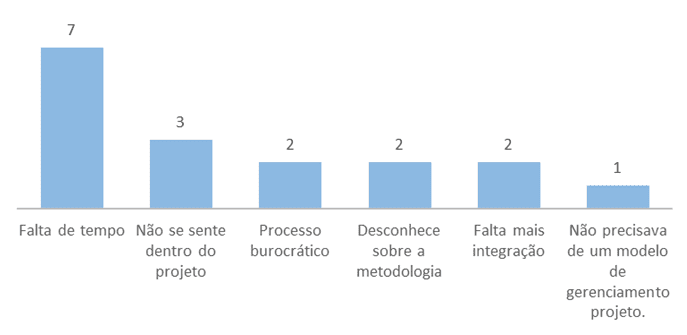
4.3 Validation
To further deepen the research, information was collected through observations in order to validate the interview reports and to identify more barriers that were not mentioned in previous reports, but which could oppose the implementation of the GP model. Table 5 shows the validation of the topics highlighted in the interviews.
Table 5: Verification via Observation
| Main comment | Validated by observation | Barrier |
| Missing more integration | There was no project alignment meeting, so it was not known at what stage the project was going. | Lack of communication. |
| Did not need a project management model. | Industrial Engineering is an area that will act mainly in projects of improvement of the production, this generates discomfort to the collaborators. | Organizational culture. |
| Lack of time | Stuck in day-to-day business processes, they do not give importance to improvement projects. | Low involvement of stakeholders / Non-involvement of project sponsors. |
| You do not know about the methodology | There was no formalization of any training on the GP model. | Scope Change. |
| Do not sit inside the project | Lack of communication regarding the progress of projects. | Low involvement of stakeholders. |
| Bureaucratic process | The process was not bureaucratic, what was lacking was the custom of using the new method. | Organizational culture. |
Source: The authors themselves
In the observation process, it was realized that the lack of time was the main problem presented by stakeholders. It came from an accumulation of operational tasks and improvement projects were not priorities. When they had to choose, they chose the activities in their area and, as a result, delays were observed in the delivery deadlines. As delivery delays occurred, the project manager charged them and their feelings were bothersome, they did not feel as part of the program.
On the argument of the Production and Quality coordinators, who claimed the lack of integration, it was found that they did not really have alignment meetings, and when a project started, the only ones they knew were the directors of the company. With this, the areas could not be programmed and contribute more. The lack of alignment is also the cause for those who said they did not feel inside the projects. The only one who said about not needing a project management model was the Production Manager. During the investigation, what was observed was that the area with the highest demands and the most operational was the Production sector. The boss's fear was that for the completion of some tasks, he needed production shutdowns. For him, this was seen as a loss and not a benefit.
Regarding the methodology bureaucracy, those who claimed this characteristic were not accustomed to registration, documentation and steps to achieve goals, since they came from a functional culture, always focusing on action rather than planning.
The lack of knowledge of the methodology was confirmed, as there were no records of any training on the GP method. It can lead to barriers such as reworking in scope changes, for not detailing risks or threats to the project.
Within the remarks it was understood that the lack of time was caused by not having an alignment between the project sponsor and the team leaders, who in turn did not provide the necessary time to devote their responsibilities within the projects. Based on this, Figure 5 shows the update of the counts referring to the problems encountered in the interviews and the validation by observation.
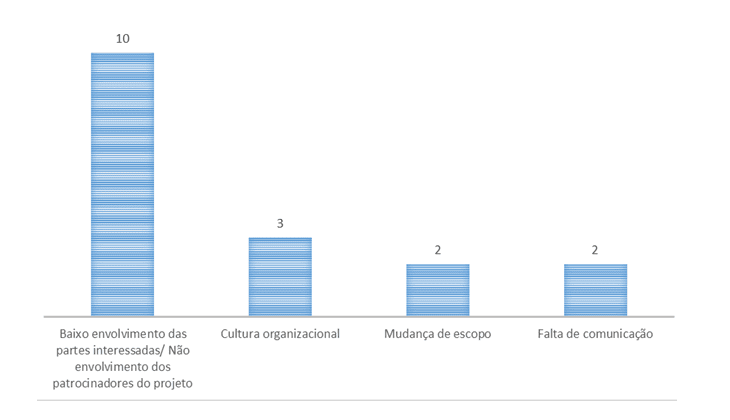
4.4 Analysis of barriers encountered
Based on the theoretical review on project management methods, it enabled the relationship between the barriers encountered and which GP models can provide assistance, to solve the difficulties encountered. Table 6 shows how each GP method can contribute to the solution of the barriers:
Table 6: Contribution of GP methods to solution of barriers found
| Barriers found | GP method | Method Focus | Actions from the method |
| Change of scope. | PMBOK | Processes | Form via integrated system to the main stakeholders. |
| Non-involvement of sponsors.
Organizational culture. |
PRINCE2 | Integration of areas | Monthly alignment with the board of directors and key areas of the company along with key stakeholders in the project. |
| Lack of communication.
Organizational culture. |
SCRUM | Performance | Weekly meeting to present project status and next steps. |
| Low involvement with stakeholders. | APM | Quick product delivery | Routine individual alignments with those involved in the project, directly in their work environment, bringing closeness and participation. |
Source: The authors themselves
CONCLUSIONS
This work was carried out during the implementation of a project management model to manage improvements in the area of industrial engineering. The implementation was divided into 5 phases and the objective of the study was to identify the barriers in phase 1, through the action-research approach.
It was sought to understand the first impacts on the use of GP methods in a company, which was accustomed to an organizational culture whose prioritization was always the routine. As a result, improvements could not be made, without anyone focusing on the management of industrial projects, while the operational managers were left with prioritization of the routines.
In the collection of data it was noticed that the main ones involved with the implantation were uncomfortable with the change. Because it was a new organization in the market, with its annual revenue considered large, the team worked with the goal in production and any activity that could take them out of the routine, was considered a waste of time.
Within this scenario, barriers such as non-involvement of project sponsors, low stakeholder involvement, organizational culture, scope changes and lack of communication were encountered.
It was highlighted as the main impediment, the non-involvement of the sponsors, which in turn was related to the non-involvement of the interested parties. As the sponsors did not participate, the stakeholders did not see the implementation of the GP model as a strategic purpose of the company. As the objective had not spread from the strategic to the operational part, the operational managers did not provide part of the time of their team for tasks in industrial projects.
The bibliographic review presented some models of management of existing projects and their perspectives. It was possible to associate the focus of some GP standards as a guide to the discovery of potential ways to solve the problems encountered. For the next phases of the implementation, it is essential to go into some actions already shown previously. According to the barriers encountered and the focus of each method studied, it is possible to cure the problems.
This work is limited to the lifting of barriers, in the progress of a deployment of a project management model, in an area of Industrial Engineering. However, it also contributes with this knowledge to the academy, since there are few works with this objective.
The case studied in this company is unique, so you can not generalize the results. For future studies, it will be fundamental to extend the objective of this work, for other phases in implementation, for companies of different sizes, in different branches of activity and for more areas within the organizations.
REFERENCES
AMARAL, D.C .; CONFORTO, E. C .; BENASSI, J. L. G .; ARAUJO, C. Agile project management: application in innovative products. São Paulo: Saraiva, 2011. 240p.
BRAZILIAN ASSOCIATION OF FOOD INDUSTRIES. 2016 Billing. São Paulo: ABIA, 2016. Available at: <http://www.abia.org.br/vsn/anexos/faturamento2016.pdf>. Accessed on: September 3, 2017.
BIRCHAL, S. O. U. Company and food industry in Brazil. Belo Horizonte: IBMEC, 2004.
BRANDÃO, H. Project management: A comparison between PMBOK and APM. 2010 102 f. Completion of course work (Monograph) – Course of Computer Science, Federal University of Lavras, Lavras, 2010.
COSTA JUNIOR, J.F. Public Policies for the Defense of Competition: The Case of the Food Industry of Brazil. São Paulo, 2009. 38p. Course Completion Work (bachelor in Public Policy Management of the School of Arts) – School of Arts, Sciences and Humanities, University of São Paulo, São Paulo.
COUGHLAN, P .; COGHLAN, D. Action Research: Action research for operations management. International Journal of Operations & Production Management. Dublin, Vol. 22 No. 2, p. 220-240, 2002.
DIAS, A. Production and Operations Administration. 1. ed. Rio de Janeiro: SESES, 2015.
MARTINS, G. F. Quantitative and Qualitative Approaches. In: MIGUEL, P. A. C. Research methodology for production engineering and operations management. 2. ed. Rio de Janeiro: Elsevier, 2012. P. 48-63.
GUIMARÃES FILHO, C. The PRINCE2 methodology and its use in the management of IT projects. São Paulo, 2013. 98.p. Monograph (Technologist in Data Processing) – Faculty of Technology of São Paulo, São Paulo.
INSTITUTE OF INDUSTRIAL AND SYSTEMS ENGINEERS (IISE). Industrial Engineering, Knowledge Skill. Available at: <http://www.iise.org/details.aspx?id=43631>. Accessed on: 07 October 2017.
KERZNER, H. Project Management: Best Practices. 2.ed. (trans. Lene Belon Ribeiro), Porto Alegre: Bookman, 2006.
LARSON, E .; GOBELI, D. Significance of project management structure on development success. IEEE Transactions on Engineering Management, v. 36, n. 2, p. 119-125, 1999.
OFFICE OF GOVERNMENT COMMERCE. Managing Successful Projects with PRINCE2 – London, The Stationery Office (TSO), 2009.
PATAH, L. A .; CARVALHO, M. C. Project management structures and skills in project teams. In: NATIONAL MEETING OF PRODUCTION ENGINEERING, 17, Curitiba, 2002. Anais … Porto Alegre: ABEPRO, 2002. P. 1-8.
PATAH, L. A .; CARVALHO, M. C. Alignment between organizational structure of projects and manufacturing strategy: a comparative analysis of multiple cases. Management & Production, São Carlos, v. 16, n. 2, p. 301-312, 2009.
PROJECT MANAGEMENT INSTITUTE (PMI). A Guide to the Project Management Body of Knowledge (PMBoK Guide). 5.ed. Four Campus Boulevard: PMI, 2013.
SATO, G. S. Profile of the food industry in Brazil: 1990-1995. Research report No. 17/1997. São Paulo: EAESP / FGV / NPP, 1997.
SCHWABER, K. Agile Project Management with Scrum. 1. ed. States of America: Microsoft Press, 2004.
VOLLMANN, T .; BERRY, W .; WHYBARK, D. Manufacturing Planning and Control Systems. 4a. Ed. Boston: Irwin McGraw-Hill, 1997.
[1] Department of Production Engineering, University of Araraquara (UNIARA)
[2] Department of Production Engineering, University of Araraquara (UNIARA)
[3] Department of Production Engineering, Federal University of São Carlos

